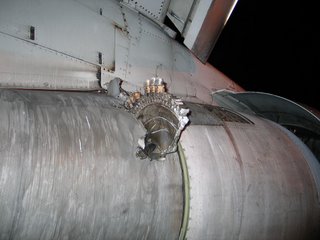




Quote from a big red friend.
This is why I don't like sitting next to the engine when I fly. The disk broke out of its own engine, went through the bottom of the fuselage, and almost went completely through the engine on the other wing. This happened during a ground test a short while after the passengers disembarked from a JFK to LAX flight. Thankfully, no one was hurt and it was a GE engine
At 1230 PM, Friday, June 2, 2006 at LAX. American Airlines Boeing 767 doing a high power engine run had a #1 engine HPT failure. HPT let go and punctured left wing, #2 engine, peppered fuselage and set fire to the aircraft. The turbine disk exits the engine and slices through the aircraft belly and lodges in the outboard side of the #2 engine.
1 comment:
Is that a jet engine??? What the hell is that?
Post a Comment